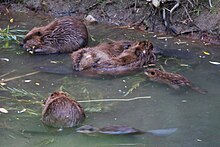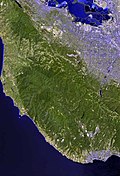Los Gatos Creek (Santa Clara County)
| Los Gatos Creek Arroyo de Los Gatos, Jones Creek Chemeketa Park | |
|---|---|
| Physical characteristics | |
| Source | Loma Prieta Mountain in the Santa Cruz Mountains |
| • coordinates | 37°06′36″N 121°50′48″W / 37.11000°N 121.84667°W[2] |
| • elevation | 3,250 ft (990 m) |
| Mouth | Guadalupe River |
• location | San Jose, California |
• coordinates | 37°00′02″N 121°53′57″W / 37.00056°N 121.89917°W[2] |
• elevation | 69 ft (21 m)[2] |
| Basin features | |
| Tributaries | |
| • left | Moody Gulch,[3] Aldercroft Creek, Briggs Creek, Black Creek, Lyndon Canyon Creek, Trout Creek |
| • right | Austrian Gulch, Hooker Gulch Creek, Hendrys Creek, Soda Springs Creek, Limekiln Canyon Creek, Dry Creek |
The Los Gatos Creek runs 24 miles (39 km) in
The creek begins in the Santa Cruz mountains near the
History



The creek was named after the
In 1866, extreme flooding of the Los Gatos Creek caused it to naturally cut a new channel in what is now the Willow Glen neighborhood of San Jose, running west and north of its original channel. The reshaped creek left behind a dry creek bed, known as Dry Creek. Today's Dry Creek Road runs parallel to the creek bed.[6]
The construction of State Route 17 in the 1950s forced much of the creek through Los Gatos to be diverted into a concrete gulch. As a Caltrans magazine from the era describes it: "Included in this project is a relocation of Los Gatos Creek for a distance of 6,000 feet, requiring a concrete line channel." The Los Gatos Daily Times on Aug. 31, 1954, reported that "bulldozers have virtually completed clearing and leveling the bed of Los Gatos Creek, and preparations are readied for laying the concrete culvert."
Also in the 1950s, the construction of the James J. Lenihan Dam formed Lexington Reservoir, which flooded much of a small valley above Los Gatos, including the former townsites of Lexington and Alma. The dam and reservoir were completed in 1952, forcing the rerouting of Highway 17. When the reservoir's water level is low, the concrete bed of the old highway through those towns can be seen, along with foundations from some buildings. In spite of these events, much of the creek maintains its natural course and beauty.
Below
Habitat and wildlife



Only five fish species were documented historically in the Guadalupe River watershed including rainbow trout, Sacramento sucker, roach, prickly sculpin, and three-spined stickleback (in brackish ponds and sloughs near the bay).
Today, Chinook salmon (Oncorhynchus tshawytscha) migrate up the Guadalupe River and Los Gatos Creek from San Francisco Bay. Both Chinook and steelhead have been spotted as far up the creek as Hamilton Avenue (see inset photo). Chinook salmon arrived in the Guadalupe River watershed (which includes Los Gatos Creek) as Central Valley hatchery strays in the 1980s. While a 1992-1994 genetic study of 29 fish claimed that some had haplotypes not found in Central Valley wild or hatchery salmon, but found in the Russian River,[11] it was later determined that the methodology used was insufficient and provided inaccurate results. Chinook salmon in the Guadalupe River are closely related to Central Valley fall-run Chinook with a genetic affinity to the Feather River hatchery and genetically differentiated from coastal populations.[12]
Between Lake Elsman and Lexington Reservoir, the creek is pristine and closed to the public. Here, along with rainbow trout,
Osprey (Pandion haliaetus) began to re-colonize the watershed after at least a 150-year absence with documentation of nesting sites in 2004.[17]
Watershed
The Los Gatos Creek sub watershed drains 55.1 square miles (143 km2).
Recreation
The
See also
References
- ^ ISBN 1-884995-14-4.
- ^ a b c U.S. Geological Survey Geographic Names Information System: Los Gatos Creek
- ^ "Moody Gulch". Geographic Names Information System. United States Geological Survey, United States Department of the Interior.
- ^ Wiley, Neil. "Lake Elsman". Mountain Network News. Mountain Network News. Retrieved 23 February 2012.
- ^ "Guadalupe Watershed". Santa Clara Valley Urban Runoff Pollution Program. Retrieved 2010-11-14.
- ISBN 0-9641102-1-0.
- ^ "Measuring Land Subsidence From Space, USGS Fact Sheet-051-00". U. S. Geological Survey. April 2000. Retrieved November 5, 2009.
- ISBN 0-520-23629-7.
- ^ John Otterbein Snyder. "Notes on the Fishes of the Streams Flowing into San Francisco Bay, California". Department of Commerce and Labor Report of the Bureau of Fisheries 1904. Washington Government Printing Office 1905.
- ^ John Otterbein Snyder. "Water Storage in Santa Clara County". Biennial Report Fish and Game Commission 1934 V20(2).
- ^ Nielsen, J. L. (1995). Mitochondrial DNA Frequency Distributions in Chinook Salmon from the Sacramento-San Joaquin Basin and Guadalupe River 1992-1994, California Department of Fish and Game Technical Report FG 2081 IF (Report). Sacramento, California and Monterey, California: California Department of Fish and Game, Anadromous Fisheries Division and Hopkins Marine Station, Stanford University.
- ^ Garcia-Rossi, Dino and Dennis Hedgecock (2002). Provenance Analysis of Chinook Salmon (Oncorhynchus tshawytscha) in the Santa Clara Valley Watershed (Report).
- ^ Lisa M. Krieger (Oct 5, 2009). "Tracking the big cats". San Jose Mercury News. Retrieved Nov 25, 2009.
- ISBN 0-520-24851-1.
beaver.
- ^ "Castor canadensis subauratus USNM 580354". Smithsonian National Museum of Natural History. Retrieved 2013-04-22.
- ISBN 978-0-89301-071-3.
- ISBN 978-0-9796038-0-8.
- ^ TetraTech, Inc. (2005-05-20). Guadalupe River Watershed Mercury TMDL Project (PDF) (Report). Retrieved 2014-07-20.
External links
- South Bay Clean Creeks Coalition website
- 2014 Video on homeless problem and creek clean-ups progress
- Los Gatos Creek & Guadalupe River Watershed maps page at Guide to San Francisco Bay Area Creeks
- Video of Chinook Salmon running up Los Gatos Creek in Willow Glen in 1996
- Santa Clara Valley Water District Homepage
- Santa Clara Valley Water District's Guadalupe Watershed
- Worth a Dam organization


